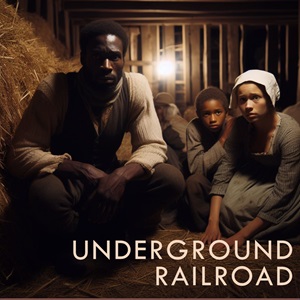


People involved with the story of Pennsylvania's Underground Railroad network, including activists, freedom seekers, station masters, conductors, financiers, lawyers, slave hunters, abolitionists, anti-slavery and pro-slavery adherents, politicians, heroes, villains, and more.
Study Areas
Who's Who in Pennsylvania's Underground Railroad
S Surnames
- Sailor, George, 1820-1873
- Location: Cumberland County; Role: Underground Railroad activist
Documentation: Richard L. Tritt, "The Underground Railroad at Boiling Springs," in At a Place Called the Boiling Springs, Richard L. Tritt and Randy Watts, editors, 1995, pp. 111-117. "The Impact of the Fugitive Slave Law on Harrisburg: A Case Study," Pennsylvania Magazine of History and Biography 109 (October 1985, 537-569).
George Sailor was a neighbor of Daniel Kaufman and actively aided Kaufman in moving and sheltering fugitive slaves that came through the Boiling Springs area.
- Sanders, John
- Location: Harrisburg; Role: Slave catcher
Documentation: Gerald G. Eggert, "The Impact of the Fugitive Slave Law on Harrisburg: A Case Study," Pennsylvania Magazine of History and Biography 109 (October 1985, 537-569).
Harrisburg man who cooperated with United States Commissioner Richard McAllister in rounding up suspected fugitive slaves and detaining them for hearings. Although not one of the Harrisburg constables regularly employed by McAllister as deputies, Sanders was involved wherever additional help was needed in catching slaves. Sanders was tried in April 1851 on kidnapping charges regarding an incident in which four fugitive slaves were taken directly to Baltimore instead of being given a hearing in front of U.S. Commissioner McAllister. In April 1853 he fled the state rather than face kidnapping charges in a separate incident involving a free African American. Sanders returned to Harrisburg and again faced charges in May 1857 for the attempted kidnapping of a local free Black man. This time he was convicted and sentenced to five years at hard labor in the county prison.
- Scates, Charles W. 1817 - 1873
- Location: Williamsport, Lycoming County; Role: UGRR stationmaster
Documentation: Marshall R. Anspach, Ed., Historical Sketches of the Bench and Bar of Lycoming County, Pennsylvania, 1961.
On several occasions, Williamsport lawyer Charles W. Scates sheltered and fed fugitive slaves before they were led by a conductor to African American homes in the location just north of town known then as "Nigger Hollow," (now Freedom Road) in Loyalsock Township. The "Roderick house" in that location was specifically mentioned as the destination in an 1864 incident.
- Schmucker, Samuel Simon 1799 - 1873
- Location: Gettysburg, Adams County; Role: Abolitionist; UGRR stationmaster
Documentation: Seminary Ridge Historic Preservation Foundation, "Preserving Legacies for Futures to Come," http://www.seminaryridge.org/legacy/Historicalstructures_files/Historical%20Structures.htm, accessed January 15, 2006 .
Professor Samuel Simon Schmucker was a known abolitionist, and it is believed he also sheltered fugitive slaves in his barn and home near the Lutheran Theological Seminary, on Seminary Ridge in Gettysburg. Schmucker founded the seminary in 1832 and built his home there the following year. Many historians believe his home was ransacked by invading Confederate troops in 1863 because of his well-known abolitionist beliefs. His 1850 household, according to the Adams County census, consisted of twelve persons, including Jesse, age 70, and Clarissa, age 60, two Virginia-born former slaves that came with his second marriage, and whom he manumitted upon moving to Pennsylvania.
- Shaeffer, Michael
- Location: Harrisburg; Role: Slave catcher
Documentation: Gerald G. Eggert, "The Impact of the Fugitive Slave Law on Harrisburg: A Case Study," Pennsylvania Magazine of History and Biography 109 (October 1985, 537-569).
Harrisburg man who cooperated with United States Commissioner Richard McAllister in rounding up suspected fugitive slaves and detaining them for hearings. Although not one of the Harrisburg constables regularly employed by McAllister as deputies, Shaeffer was involved wherever additional help was needed in catching slaves. Gerald Eggert notes that Shaeffer "frequently assisted at slave-catching" (p. 546). Shaeffer was charged with assault and false arrest in an 1851 incident in which he threatened to shoot an innocent local man, John Dunmore, if he did not confess to being a fugitive slave.
- Shaw, Robert
- Location: Sugar Creek Township, Venango County; Role: UGRR stationmaster
Documentation: Herbert C. Bell, History of Venango County, 1890.
Farmer and prominent citizen of Sugar Creek Township, Robert Shaw sheltered and fed fugitives slaves on his property before conducting them to the next station.
- Shockey, Jacob
- Location: Washington Township, Franklin County ; Role: UGRR stationmaster,
conductor
Documentation: G. Craig Caba, Episodes of Gettysburg and the Underground Railroad, 1998, p. 100.
- Slick, William, Sr.
- Location: Conemaugh Township, Cambria County ; Role: UGRR stationmaster,
conductor
Documentation: Henry W. Storey, History of Cambria County, 1907, p. 186-192.
William Slick, Sr. was a farmer near Johnstown who aided fugitive slaves. He was active as early as 1837, when two fugitives who had been shot while being pursued were brought to his farm for medical attention. The severely wounded fugitives, two young men, were taken to Johnstown for medical care, and when well enough to travel, were forwarded to the next station before their owners could get them back.
- Smith, Lydia Hamilton
- Location: Lancaster City, Lancaster County ; Role: Probable UGRR stationmaster and activist.
Documentation: See "About The Thaddeus Stevens & Lydia Hamilton Smith Center for History & Democracy." at Lancaster History.org: https://www.lancasterhistory.org/about-sschd/.
Lydia Hamilton Smith was a mixed-race housekeeper and confidant to Thaddeus Stevens for twenty years, at his home at Queen and Vine Streets in Lancaster. Historical excavation of a cistern beneath that home revealed clues of probably use as an Underground Railroad shelter. Stevens' involvement with the Underground Railroad is well established. As housekeeper for decades during a time of high Underground Railroad activity in the area, Smith must have been aware and a sympathizer, and more likely an active participant. Smith's relationship to Stevens was intimate, if not romantic. Jonathan Blanchard, who knew Stevens well, described Smith as "the woman who had taken care of him for more than twenty five years [as] a wife."
- Smith, Stephen
- Location: Columbia, Lancaster County; Role: Abolitionist and UGRR
stationmaster
Documentation: "The Columbia Race Riots," William Frederic Worner. Papers Read Before the Lancaster County Historical Society, October 6, 1922, in Journal of the Lancaster County Historical Society, Vol. XXVI (1922), No. 8, page 175.
Stephen Smith became one of the most famous and successful residents of Columbia, Pennsylvania and at one point was said to be the richest Black man in America. He became a business partner with William Whipper, an African-American lumber merchant and another former slave who rose to prominence, and together they helped many hundreds of Blacks to freedom on the Underground Railroad. In some instances, fugitives were smuggled to Philadelphia in false end boxcars owned by Smith and Whipper. Stephen Smith moved to Philadelphia in 1842 but left his lumber and coal business in Columbia under the management of William Whipper.
- Smith, William
- Location: Columbia, Lancaster County; Role: Murdered fugitive slave
Documentation: “Murder of a Supposed Fugitive,” The National Era, May 6, 1852; “The Fatal Slave Case at Columbia,” Frederick Douglass Paper, May 13, 1852; “The Columbia Murder,” The National Era, May 20, 1852; May 27, 1852.
In May 1852, Harrisburg’s Solomon Snyder and Henry Lyne, accompanying Baltimore police officer A.G. Ridgely with a warrant for a fugitive slave believed to be living in Columbia, found their man, William Smith, working at a lumberyard in that town. Snyder and Ridgely took hold of Smith, who apparently struggled somewhat before Ridgely drew a pistol and shot him in the neck. The bullet severed his jugular vein and Smith died within two minutes. Ridgely agreed to give himself up, but instead fled to Maryland, and the two other lawmen returned to Harrisburg.
- Snyder, Solomon
- Location: Harrisburg; Role: Slave catcher
Documentation: Gerald G. Eggert, "The Impact of the Fugitive Slave Law on Harrisburg: A Case Study," Pennsylvania Magazine of History and Biography 109 (October 1985, 537-569); "Serious Accident," The Liberator, 24 July 1846
Harrisburg constable who worked closely with United States Commissioner Richard McAllister in rounding up suspected fugitive slaves and detaining them for hearings. Snyder and several fellow constables employed questionable legal tactics in finding and handling accused fugitives, and was brought up on kidnapping charges as a result of an incident in 1853. Although not convicted in 1853, he was found guilty of kidnapping in a separate incident in 1855 and sentenced to six years in prison. Snyder had lost an arm due to the premature discharge of a cannon at a July Fourth celebration in Harrisburg in 1846.
- Speakman, Micajah 1781 - 1852
Speakman, William - Location: Wallace Township, Chester County; Role: UGRR stationmasters,
conductors
Documentation: Robert C. Smedley, History of the Underground Railroad in Chester and the Neighboring Counties of Pennsylvania, 1883, repr. 2005, Stackpole Books, p. 164-165.
Chester County farmers who were an important link in that county's UGRR network. Smedley notes that hundreds of fugitives passed through the hands of these men, and that they provided shelter, food, clothing and medical care when needed. Fugitives were hidden in the barn, then given directions to walk to the next station. If transportation was required, William would accompany them. They generally sent fugitives to Jacob Haynes.
- Stem, Rev. Nathan ____ - 1859
- Location: Harrisburg; Role: abolitionist, political activist
Documentation: .Hiram Rutherford, "Pastors and Elders," in Egle's Notes and Queries, Fourth Series, Vol. 1, p. 324. History of Delaware and Ohio, 1880, p. 393. Ellwood Robert's Biographical Annals, 1904: Montgomery County, Pennsylvania, Volume I, Part 17, p. 385.
Rev. Nathaniel Stem came to Harrisburg in the early 1830s from Delaware, Ohio, to become pastor of St. Stephen's Episcopal Church. Rev. Stem was one of only two Harrisburg pastors to take a prominent stand against slavery, the other being Rev. John Winebrenner. In 1836, Rev. Stem helped organize the Harrisburg Anti-Slavery Society, and served as its first president. The following year he became an officer of the newly organized Pennsylvania Anti-Slavery Society. Rev. Stem moved to Norristown, where he became rector of St. John's Episcopal Church, serving in that capacity from 1839 until his death in 1859.
- Stephenson, William M.
- Location: Mercer Borough, Mercer County; Role: UGRR Stationmaster; abolitionist
Documentation: History of Mercer County, 1888, p. 260.
Prominent Mercer attorney whose home, according to his biography, was a station on the underground railroad. Stephenson studied with John J. Pearson, who is believed to have aided the local UGRR activists in Dauphin County.
- Stevens, Thaddeus
- Location: Adams County; Lancaster city, Lancaster County; Role: UGRR stationmaster, activist, politician, abolitionist.
See also: Lydia Hamilton Smith.Documentation: See numerous sources on special study page: Thaddeus Stevens and the Underground Railroad.
Prominent state and national politician, advocate of abolition, free public education, and civil rights. Sheltered a large group of twenty-six freedom seekers from Maryland that were forwarded to his Lancaster city home and office in 1842. He fed them and made arrangements to get them to stationmaster Daniel Gibbons in rural Lancaster County.
- Still, William
- Location: Philadelphia ; Role: UGRR activist
Documentation: William Still, The Underground Railroad, 1872.
New Jersey born William Still moved to Philadelphia in the 1840's where he eventually found work with the Pennsylvania Society for the Abolition of Slavery and soon became involved with helping fugitives to freedom, hiding some freedom seekers in his own house. He became chairman of the Philadelphia Vigilance Committee in 1852, and began keeping careful notes about the operations and details of area Underground Railroad networks. He organized his collected notes into a book, The Underground Railroad, and published it in 1872.
- Stright, Amzi S.
- Location: Sandy Creek Township, Mercer County; Role: UGRR Stationmaster
Documentation: History of Mercer County, 1888
Amzi Stright moved to Mercer County from Washington County. His home was used as a station on the underground railroad.
- Swisshelm, Jane Grey 1815-1884
- Location: Pittsburgh, Allegheny County ; Role: Abolitionist activist and
publisher
Documentation: Arthur J. Larsen, Editor, "Crusader and feminist; letters of Jane Grey Swisshelm: 1858-1865," Library of Congress, American Memory, http://memory.loc.gov/ammem/index.html , accessed 8 October 2006.
- Sykes, Joseph
- Location: Mercer, Mercer County ; Role: UGRR conductor
Documentation: Elizabeth Agnes Kilgore, "History of Mercer," unpublished manuscript, 1930.
The farm of Jacob Shockey was located just over the border from Maryland, at the foot of the South Mountain range. Shockey's was the first UGRR station encountered in Pennsylvania by fugitive slaves crossing the border in this area. Fugitives were generally sheltered in the forest before being led about eight miles to the Wertz farm near the village of Quincy.
Journalist Jane G. Swisshelm's Saturday Visiter [sic], begun in 1848, gained notoriety as an abolitionist/reformer publication that called for active resistance to the 1850 Fugitive Slave Act.
Joseph Sykes was an English-born wagon maker in Mercer Borough. He would drive a "big wagon" loaded with fugitive slaves from the house of James Kilgore in Mercer, to Mr. Couse's station at Sheakleyville. Ms. Kilgore, daughter of James Kilgore, witnessed these events, which she dated circa 1856.
